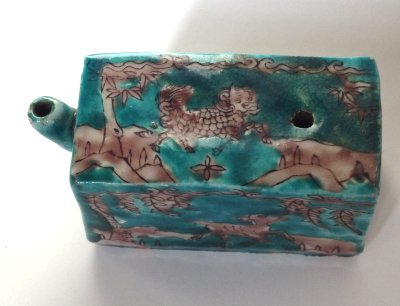
Water dropper in the shape of a box. While blocking air with the tip of a finger the stream of water can be regulated. Decoration of mythical animals, also related to military ranks. Crackled turquoise and purplish brown lead glaze. Possible Ming dynasty, Wanli period (1573-1620), cf. J Harrison-Hall, Ming Ceramics in the British Museum p. 342-343.
The small decorative and utilitarian objects associated with the scholar's desk are collectively referred to as scholar's desk objects or literati objects. These items were integral to the life and work of literati, embodying both functional and aesthetic qualities. They were designed to support the scholar's activities, such as writing, painting, and contemplation, while also reflecting their refined taste and intellectual pursuits.
A scholar might have a number of different items on his table.
The material used for the artistic objects varied greatly, from bamboo to stone, ivory, wood and metal, but ceramics were by far the most commonly used material, even though ceramics rated lowest in ranking of importance. Bamboo, ivory or wood might not be durable enough and metal was sometimes too heavy, but ceramic objects could be thrown or moulded in to an infinite variety of forms.
Most of the objects made centered around the functions of writing and painting. Brush pots of different sizes and shape were needed to hold the various types of brushes, the same applies to brush rests. Water droppers for adding water to dry solid ink when it was ground on an ink stones, as well as the ink stones themselves were all needed, as were water-pots that the scholar could also require as a source of clean water to moisten his brush and a brush washer, which would be a relatively shallow dish to allow the scholar to rinse color or ink from his brush.
In addition there might be an ink stand on which to rest the ink stick, an incense burner and perhaps a table screen. Wrist rests, paper weights and seals themselves as well as seal box or tray and the seal mud container also belongs to this group. All of these could be made of porcelain.
But these were not merely functional items, some conveyed symbolic mean, often enhancing scholarly virtues and the wish for longevity. Small garden stones, intriguingly made jade or stone objects, root and wood carvings occurs as well as various kinds of miniatures. All were meant to inspire the writer, poet and artist but could also exhibit a sense of humor.
And all these items would be chosen for their individual aesthetic appeal.
Of porcelain pieces for the scholar's table, the badama or 'the eight classic shapes', have a special standing. Since the actual number of shapes eventually were more than eight, it is likely that the name "eight" was used here as a honorific label.
Objects for the scholar`s desk were made out of many different ceramic bodies, during the Song Dynasty (960-1279) Qingbai porcelain was most frequently used, often in moulded form but by the late 17th and early 18th century biscuit porcelain with colored glazes such as green, aubergine or turquoise were popular. It appears highly likely some of these objects were shipped to Europe at the time, especially France and were they were seen as whimsical novelties divorced from their true scholarly function
Inkstones (硯, Yàn):
Brush Holders (筆筒, Bǐtǒng):
Brush Rests (笔架, bǐjià):
Water Droppers (水滴, Shuǐdī):
Seals (印章, yìn zhāng) and Seal Paste Boxes (印泥盒), yìn ní hé):
Paperweights (镇纸, Zhènzhǐ):
Incense Burners (香炉, Xiānglú):
Miniature Landscapes and Bonsai:
Porcelain and Lacquer ware:
A